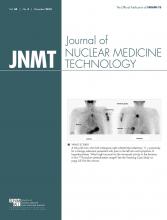Abstract
Primary gastric lymphoma (PGL) accounts for less than 4% of gastric neoplasms. 18F-FDG PET with simultaneously acquired CT (18F-FDG PET/CT) allows for staging and differentiation from other gastric cancers. Rapid diagnosis and staging are important because chemotherapeutic response is generally favorable. We describe a case of an 83-y-old woman with stage II1 PGL. 18F-FDG PET/CT can be helpful to differentiate various gastric masses and is an important factor in the staging of PGL.
PET/CT with 18F-FDG can be useful to differentiate PGL from other nonlymphomatous gastric cancers and provides more accurate staging information, as illustrated by this case report.
CASE REPORT
An 83-y-old woman presented with fatigue, weight loss, upper abdominal pain made worse by eating, and a palpable mid-epigastric mass. A CT scan noted wall thickening of the gastric pylorus and body, measuring up to 1.1 cm, and an enlarged 1.4-cm lymph node adjacent to the right gastroepiploic vessels. PET/CT obtained 70 min after the injection of 442.15 MBq (11.95 mCi) of 18F-FDG demonstrated diffuse gastric wall hypermetabolism and avidity of the enlarged lymph node and an SUVmax of 25 and 15.3, respectively (Fig. 1). Upper endoscopy revealed a large ulcerated distal gastric body and antrum mass extending across the pylorus. Subsequent biopsy was consistent with diffuse large B cell lymphoma and the patient was diagnosed with stage II1 gastrointestinal lymphoma. A CT scan 1 mo after chemotherapy showed improvement (Fig. 2).
Marked diffuse gastric wall 18F-FDG uptake with an enlarged and avid adjacent lymph node.
One-month follow-up CT shows significant improvement.
DISCUSSION
The stomach is the most common site for extranodal lymphoma, accounting for up to 50% of gastrointestinal lymphomas (1). Primary gastric lymphoma (PGL) is most commonly either low-grade mucosa-associated lymphoid tissue lymphoma or diffuse large B cell lymphoma, which vary in terms of histology, epidemiology, morbidity, and treatment yet appear similar on imaging.
18F-FDG PET/CT is valuable in both detecting and staging PGL. The sensitivity of 18F-FDG PET/CT for detecting the diffuse large B cell lymphoma subtype of PGL is estimated to be 97%–100% (2). The high sensitivity is helpful because submucosal disease can be missed on endoscopy.
The Lugano staging system defines stage I as confined to the source organ, stage II as abdominal lymph node spread (local II1, distant II2) or adjacent organ involvement (IIE), and stage IV as disseminated extranodal disease or supradiaphragmatic nodal involvement; no stage III is used. Given improved detection of unsuspected distant disease, particularly extranodal involvement, with 18F-FDG PET/CT over anatomic imaging alone, PET/CT has been shown to correctly upstage disease in 22% and downstage disease in 14% of cases (3). SUVmax has also been shown to correlate with aggressiveness, with higher uptake associated with advanced Lugano stage (2).
CT findings of focal wall thickening and secondary gastric outlet obstruction suggest gastric adenocarcinoma over PGL. 18F-FDG PET/CT, however, can quantitatively differentiate wall thickening associated with PGL and nonlymphomatous cancers because there is generally a linear relationship between SUVmax and maximal gastric wall thickness in nonlymphomatous cancers, whereas PGL does not show a correlation between the 2 measurements (4). Our patient had maximal gastric wall thickness of 1.1 cm with an SUVmax of 25.0. Wu et al. emphasize this point, showing that 18F-FDG metabolism was independent of wall thickness in PGL allowing for exceptionally avid gastric walls throughout a wide range of wall thickness, as is the case in our patient (4).
CONCLUSION
18F-FDG PET/CT can be useful to differentiate PGL from other nonlymphomatous gastric cancers and provides more accurate staging information.
DISCLOSURE
No potential conflict of interest relevant to this article was reported.
Footnotes
Published online Aug. 4, 2016.
- Received for publication April 13, 2016.
- Accepted for publication June 18, 2016.









